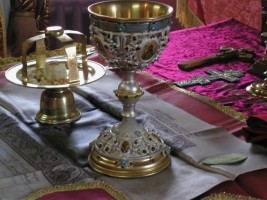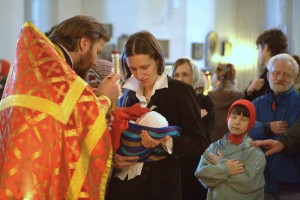Ancient Christians were subjected to vicious slanders. They were accused of atheism (for rejecting the gods of Rome), treason (for denying the emperor’s divinity), and sexual orgies (for speaking so passionately of loving one another). Even the stealing and murdering of infants – a slander later applied to European Jewry – was not beneath them. Finally, given their bizarre talk of eating the flesh and drinking the blood of a criminal who had been put to death, they were suspected of cannibalism. For these and other provocations, they would pay a price in blood.
![]() They might have acquitted themselves of this last charge had they understood the “flesh” and “blood” of their central ritual as poetic license. Instead, they took literally the gruesome intensity of Saint John the Evangelist, who presents Jesus as saying that life itself is possible only to those who eat His flesh and drink His blood.
They might have acquitted themselves of this last charge had they understood the “flesh” and “blood” of their central ritual as poetic license. Instead, they took literally the gruesome intensity of Saint John the Evangelist, who presents Jesus as saying that life itself is possible only to those who eat His flesh and drink His blood.
The belief that Eucharisic bread and wine truly become the Body and Blood of Christ is now commonly called the “real presence.” It has become a standard of division between Catholics, who retain it, and Protestants, who generally reject it in favor of a metaphorical interpretation.
Regrettably, any discussion of whether these words ought to be taken literally has been tainted by the metaphysical explanation of how such a change might be possible.
The dogma of transubstantiation emerged with the Western rediscovery of Greek philosophy. According to Aristotle, every object has both “substance” and “accidents.” The substance is the underlying essence – the “breadness” of bread. The accidents are the outer appearance – bread’s taste, texture, smell, etc. According to the metaphysics of transubstantiation, the bread and wine retain their accidents, while their substance is transformed into flesh and blood. To a modern mind, this sounds like hocus pocus – a term that is itself a corruption of the Latin “Hoc est corpus meum” – “This is my body.” Our rationalism tells us to accept as real only what is physically observable. Once considered scientific, metaphysical explanations no longer satisfy our minds, which prefer the alternative of reducing the words of the Gospel to a metaphor.
But is there a middle ground between metaphysics and metaphor?
Years ago, as a recent convert to Orthodox Christianity studying the Reformation at Pacific Lutheran University, I was stumped by the debate over trans- versus consubstantiation and decided to ask my priest where we stood.
“The Orthodox teaching on the transformation of the Eucharistic elements can be defined,” said he, “as metabole.”
Metabole??! Bracing for yet another mind-numbing metaphysic, I asked him to elaborate.
“Metabole is a Greek word meaning ‘it changes.’ We believe the bread and wine become the Body and Blood of Christ, but we don’t explain away the mystery.”
To a medieval scholastic, such an “explanation” would have seemed ignorant, but the tables have turned. When divine activity exceeds the limitations of our rational minds, the only satisfactory explanation is “mystery’,” he explained. “As one of the most influential Christian thinkers of the 16th century asked, “Why don’t we put aside such curiosity and cling simply to the words of Christ, willing to remain ignorant of what takes place here and content that the real Body of Christ is present by virtue of the words, ‘This is My Body’?”
Surprisingly, these were not the words of an Orthodox author, but of a German named Luther, writing in The Babylonian Captivity of the Church!
Today’s Lutherans might be surprised to learn how passionately Luther himself believed in the real presence, defending this teaching against more radical reformers. He even had a public debate with a Swiss adversary named Zwingli (whose claim to fame was that his denial of the real presence, in favor of a metaphorical interpretation, eventually won over Protestantism). In that forum, the Marburg Colloquy, Zwingli needled Luther with the question, “Do you munch on Christ, then?” to which Luther responded, “Yes, if that’s the way you want it!” In some ways, Luther was somewhat Orthodox after all!
Source: The Parish Newsletter of St. John the Forerunner Antiochian
Orthodox Christian Church, a local parish of the Diocese of Wichita and Mid-America
and the Self-Ruled Antiochian Orthodox Christian Archdiocese of North America



















